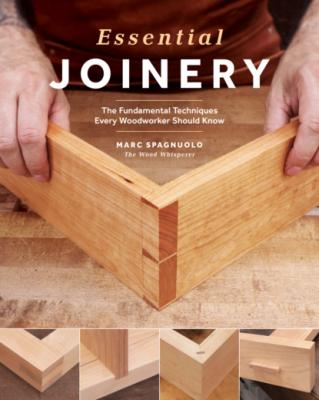ТОП просматриваемых книг сайта:
Essential Joinery. Marc Spagnuolo
Читать онлайн.Название Essential Joinery
Год выпуска 0
isbn 9781951217167
Автор произведения Marc Spagnuolo
Жанр Сделай Сам
Издательство Ingram
1
3
2
TOOLS
Biscuit joiner
Straightedge
1. Arrange the parts to be
joined and mark the center point
of the biscuits.
2. On frame parts, there usually
isn’t enough width to put more
than one biscuit side by side,
but there is enough thickness to
stack them. Set up the biscuit
joiner fence so the slot will be
off-center, with at least ⅛" of
material between the slots.
3. Wrap the pencil line
around to both faces of the
adjoining workpieces.
21
ESSENTIAL JOINERY
Butt Joints | FRAME BUTT JOINT USING DOUBLE BISCUIT
4. Plunge into both workpieces,
once on each face.
5. The slots should now be
symmetrical.
6. Add two biscuits with glue
and apply pressure to the joint.
The second biscuit doubles the
glue surface area.
4
5
6
22
ESSENTIAL JOINERY
1
2
3
FRAME BUTT JOINT USING DOMINOES
A Domino joiner works in the same way as a biscuit joiner. The only difference is
that the biscuits are replaced with loose tenons called Dominoes.
TOOLS
Square
Domino joiner
1. Arrange the parts to be
joined and mark the center point
of each Domino.
2. Set up the Domino fence so
the mortises are centered on
the thickness of the board and
plunge at each pencil line on both
adjoining pieces.
3. Insert Dominoes into the two
mortises and assemble the joint.
TIP
Domino tenons fit tightly
into their mortises and can
be very difficult to remove after a
test assembly. Use a knife or some
sandpaper to remove the little ridge
on each side of the Domino and
you’ll have a much easier time
inserting and removing the tenon
from the mortises.
23
ESSENTIAL JOINERY
CASE BUTT JOINT USING POCKET SCREWS
Using pocket screws to reinforce case butt joints is standard fare and a great choice
for kitchen cabinetmakers. It also works well in any case where face frames or other
materials will conceal the screws.
1. Arrange parts and label them
clearly. Lay out the screw
locations on the board that will
receive the pocket holes.
2. Secure the board in the
pocket screw jig as per the
manufacturer’s instructions and
drill the holes. Pay close attention
to the face you’re drilling into and
how the screws will penetrate into
the adjoining workpiece. Ideally,
we want the screws driving
toward the “meat” of the board,
and not toward the edge. But
sometimes, keeping the pockets
hidden requires exceptions.
3. Apply clamping pressure
to the joint so the boards can’t
move (glue is optional but
certainly doesn’t hurt) and drive
in the screws.
1
2
3
TOOLS
Square
Pocket screw jig
Drill
Drill bit and driver
Clamps
24
ESSENTIAL JOINERY
1
2
CORNER CASE BUTT JOINT USING BISCUITS
Another great joinery solution for casework is biscuits. Biscuits are premade
football-shaped wooden discs that slide into perfectly sized slots cut by a tool
called a biscuit joiner.
TOOLS
Adjustable square
Biscuit joiner
Clamps
1. With the two panels flat, butt
them up end to end and mark the
biscuit locations on both pieces
at once. One piece receives slots
on the face and the other receives
slots on the end of the panel. In
order to get a perfect flush joint
without changing the settings
on the joiner, transfer the marks
around to the opposite face of the
end slot panel.
2. Set up the biscuit joiner fence
so that the biscuits are centered
on the thickness of the panel.
3. Cut the slots on the end of
the panel, with the fence on the
back side of the panel.
3

